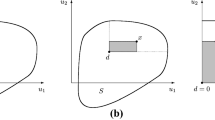Abstract
We provide two alternative characterizations of the Nash bargaining solution. We introduce new simple axioms, strong undominatedness by the disagreement point, and egalitarian Pareto optimality. First, we prove that the Nash solution is characterized by symmetry, scale invariance, independence of irrelevant alternatives, and strong undominatedness by the disagreement point. Second, we replace the independence of irrelevant alternatives axiom with the sandwich axiom (Rachmilevitch in Theory Decis 80:427–442, 2016) and egalitarian Pareto optimality. We then demonstrate that the Nash solution is characterized by symmetry, scale invariance, strong undominatedness by the disagreement point, the sandwich axiom, and egalitarian Pareto optimality.

Similar content being viewed by others
Notes
See, for example Mariotti (2000).
Although we deal with the two-person case throughout, all arguments in this paper work in the more-than-two-person case.
For \(s,r\in \mathbb {R}^{2}, s \ge r \) if \(s_{i }\ge r_{i}\) for each i , \(s > r\) if \(s_{i }\ge r_{i}\) for each i and \(s \ne r\), and \(s\gg r\) if \(s_{i }>r_{i}\) for each i.
We say that x is weakly dominated by y if \(x< y\) for \(x,y\in \mathbb {R}^{2}\).
I appreciate an anonymous reviewer’s comment.
Lemma 1 is analogous to Lemma 2 in Vartiainen (2007), which has been provided to characterize the extended Nash solution determining a solution and a reference point simultaneously.
If there was a point \(r \in \mathbb {R}^{2}\), such that \(r_{1}+r_{2 }>2\), then the convex combination of r and N(S, 0) contains a point \(u \in S\), such that \(u_{1}u_{2 }>\)1. That is a contradiction. See Nash (1950).
See Kalai and Smorodinsky (1975).
Rachmilevitch (2016) has provided a characterization of the Nash solution using the sandwich axiom (Theorem 1).
The interpretation is based on Rachmilevitch (2016).
References
Anbarci, N. (1998). Simple characterizations of the Nash and Kalai Smorodinsky solutions. Theory and Decision, 45, 255–261.
Anbarci, N., & Sun, C. (2011). Weakest collective rationality and the Nash bargaining solution. Social Choice and Welfare, 37, 425–429.
de Clippel, G. (2007). An axiomatization of the Nash bargaining solution. Social Choice and Welfare, 29, 201–210.
Kalai, E., & Smorodinsky, M. (1975). Other solutions to Nash’s bargaining problem. Econometrica, 43, 513–518.
Mariotti, M. (2000). Maximal symmetry and the Nash solution. Social Choice and Welfare, 17, 45–53.
Nash, J. F. (1950). The bargaining problem. Econometrica, 18, 155–162.
Rachmilevitch, S. (2016). Egalitarian–utilitarian bounds in Nash’s bargaining problem. Theory and Decision, 80, 427–442.
Roth, A. E. (1977). Individual rationality and Nash’s solution to the bargaining problem. Mathematics of Operations Research, 2, 64–65.
Vartiainen, H. (2007). Collective choice with endogenous reference outcome. Games and Economic Behavior, 58, 172–180.
Acknowledgements
I am deeply grateful for the helpful comments of two anonymous reviewers and the editor. In addition, I would like to thank Mr. Jerre Bush and Enago for the English language review. I acknowledge support from Jobu University.
Author information
Authors and Affiliations
Corresponding author
Rights and permissions
About this article
Cite this article
Mori, O. Two simple characterizations of the Nash bargaining solution. Theory Decis 85, 225–232 (2018). https://doi.org/10.1007/s11238-017-9624-x
Published:
Issue Date:
DOI: https://doi.org/10.1007/s11238-017-9624-x




